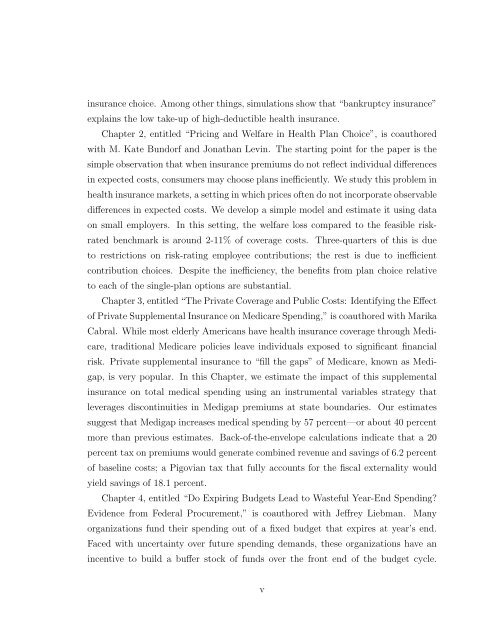essays in public finance and industrial organization a dissertation ...
essays in public finance and industrial organization a dissertation ...
essays in public finance and industrial organization a dissertation ...
Create successful ePaper yourself
Turn your PDF publications into a flip-book with our unique Google optimized e-Paper software.
<strong>in</strong>surance choice. Among other th<strong>in</strong>gs, simulations show that “bankruptcy <strong>in</strong>surance”<br />
expla<strong>in</strong>s the low take-up of high-deductible health <strong>in</strong>surance.<br />
Chapter 2, entitled “Pric<strong>in</strong>g <strong>and</strong> Welfare <strong>in</strong> Health Plan Choice”, is coauthored<br />
with M. Kate Bundorf <strong>and</strong> Jonathan Lev<strong>in</strong>. The start<strong>in</strong>g po<strong>in</strong>t for the paper is the<br />
simple observation that when <strong>in</strong>surance premiums do not reflect <strong>in</strong>dividual differences<br />
<strong>in</strong> expected costs, consumers may choose plans <strong>in</strong>efficiently. We study this problem <strong>in</strong><br />
health <strong>in</strong>surance markets, a sett<strong>in</strong>g <strong>in</strong> which prices often do not <strong>in</strong>corporate observable<br />
differences <strong>in</strong> expected costs. We develop a simple model <strong>and</strong> estimate it us<strong>in</strong>g data<br />
on small employers. In this sett<strong>in</strong>g, the welfare loss compared to the feasible risk-<br />
rated benchmark is around 2-11% of coverage costs. Three-quarters of this is due<br />
to restrictions on risk-rat<strong>in</strong>g employee contributions; the rest is due to <strong>in</strong>efficient<br />
contribution choices. Despite the <strong>in</strong>efficiency, the benefits from plan choice relative<br />
to each of the s<strong>in</strong>gle-plan options are substantial.<br />
Chapter 3, entitled “The Private Coverage <strong>and</strong> Public Costs: Identify<strong>in</strong>g the Effect<br />
of Private Supplemental Insurance on Medicare Spend<strong>in</strong>g,” is coauthored with Marika<br />
Cabral. While most elderly Americans have health <strong>in</strong>surance coverage through Medi-<br />
care, traditional Medicare policies leave <strong>in</strong>dividuals exposed to significant f<strong>in</strong>ancial<br />
risk. Private supplemental <strong>in</strong>surance to “fill the gaps” of Medicare, known as Medi-<br />
gap, is very popular. In this Chapter, we estimate the impact of this supplemental<br />
<strong>in</strong>surance on total medical spend<strong>in</strong>g us<strong>in</strong>g an <strong>in</strong>strumental variables strategy that<br />
leverages discont<strong>in</strong>uities <strong>in</strong> Medigap premiums at state boundaries. Our estimates<br />
suggest that Medigap <strong>in</strong>creases medical spend<strong>in</strong>g by 57 percent—or about 40 percent<br />
more than previous estimates. Back-of-the-envelope calculations <strong>in</strong>dicate that a 20<br />
percent tax on premiums would generate comb<strong>in</strong>ed revenue <strong>and</strong> sav<strong>in</strong>gs of 6.2 percent<br />
of basel<strong>in</strong>e costs; a Pigovian tax that fully accounts for the fiscal externality would<br />
yield sav<strong>in</strong>gs of 18.1 percent.<br />
Chapter 4, entitled “Do Expir<strong>in</strong>g Budgets Lead to Wasteful Year-End Spend<strong>in</strong>g?<br />
Evidence from Federal Procurement,” is coauthored with Jeffrey Liebman. Many<br />
<strong>organization</strong>s fund their spend<strong>in</strong>g out of a fixed budget that expires at year’s end.<br />
Faced with uncerta<strong>in</strong>ty over future spend<strong>in</strong>g dem<strong>and</strong>s, these <strong>organization</strong>s have an<br />
<strong>in</strong>centive to build a buffer stock of funds over the front end of the budget cycle.<br />
v










